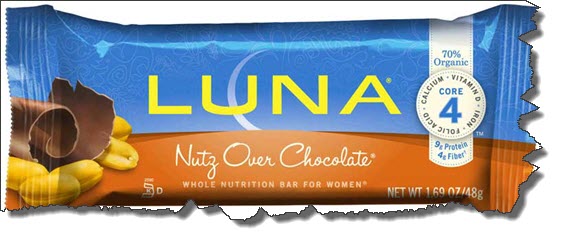
Luna is a popular bar marketed to women.
By Joan Kent, Ph.D.
Some training bars / food bars / snack bars are advertised as being for women. What does that mean? What do women”™s bars contain that men”™s bars — have you ever even heard of those? — don”™t?
Some women”™s bars contain nutrients that are apparently of concern and benefit to women. Examples are calcium, vitamin D, iron, and folic acid. It”™s my plan to keep this post brief, but I”™ll mention a little about these nutrients. (Disclaimer: This is not a nutrition primer, so it will NOT cover Everything You Always Wanted To Know About Women”™s Nutrition But Were Afraid To Ask.)
Calcium is a controversial nutrient. No one argues that it”™s not important; the controversy centers on the source. Calcium that comes from dairy foods has been shown to be effective but won”™t work for those with lactose intolerance or casein sensitivities, or for those who follow vegan dietary guidelines.
Dolomite is a calcium source considered safe for adults, although it can cause gastric problems — nausea, vomiting, diarrhea, constipation, stomach irritation — and may be contaminated with various heavy metals. (I don”™t know. How safe does that sound to you?)
Some sources advocate calcium supplements, while others warn that supplements can increase risk of heart attack and may be harmful for people with kidney disease, sarcoidosis, or parathyroid problems.
So whence derives the calcium in Women”™s Bars? I”™m guessing it”™s not from leafy greens or fish, both considered good sources. In any case, it”™s wise to consider all sources of calcium in the diet before adding more with a bar.
Vitamin D is a healthful nutrient, the importance of which has recently been stressed for women for a wide variety of health issues. Doctors vary considerably in their dosage recommendations. It”™s wise to consider all sources of vitamin D in one”™s diet, including any bars you may eat.
Iron is involved in oxygen delivery and is important for athletes and menstruating women. While the benefits of antioxidants are well known, iron is actually an oxidant and may form free radicals that can seriously damage the body. Excess stored iron increases risk of atherosclerosis, heart disease, cancer, and inflammatory bowel disease. It can destroy the insulin-producing cells in the pancreas and cause diabetes, and can contribute to Alzheimer”™s disease. Again, keep in mind all sources of iron in the diet before adding bars.
Folic acid is in women”™s bars because folate is important before and during pregnancy. They”™re not the same. Folic acid is the synthetic form of folate and is so highly absorbable that excess intake can happen easily. High intake of folic acid can mask detection of vitamin B12 deficiency. This is more of a problem in the elderly, but it”™s something to consider. Natural folate can be found in spinach, asparagus, turnip greens, mustard greens, parsley, collards, broccoli, cauliflower, beets, lentils, and both calf and chicken liver. Women”™s Bars contain folic acid.
All of this taken into account, I”™d say the main thing that makes a bar a Women”™s Bar is the high amount of sugar. Have you tasted any of them? Yikes, they”™re appallingly sweet, apparently, because women like sugary foods. It might be a good idea to stay away for that reason alone.
If anyone asked me to suggest a recipe for a women”™s bar, it would have lots of protein. Why? Women”™s brains have a higher rate of serotonin turnover than men”™s, so they need to keep making more. Serotonin is made from tryptophan, which is an amino acid. Amino acids are the building blocks of protein.
So eating more protein is important for women”™s brains. Even for those women who prefer carbs (maybe especially for them).
More protein and less sugar would make for a better Women”™s Bar. There”™s only one thing — the source of the protein. In most bars it”™s soy, and that brings in problems of gigantic proportions.
But we”™ll have to look at those in another post.
- New Year’s Resolutions: A Sugar Addict’s Survival Guide - April 15, 2024
- Motivation vs. Enthusiasm - October 12, 2023
- Why Exercise Shouldn’t Be Just One Thing - November 9, 2022
